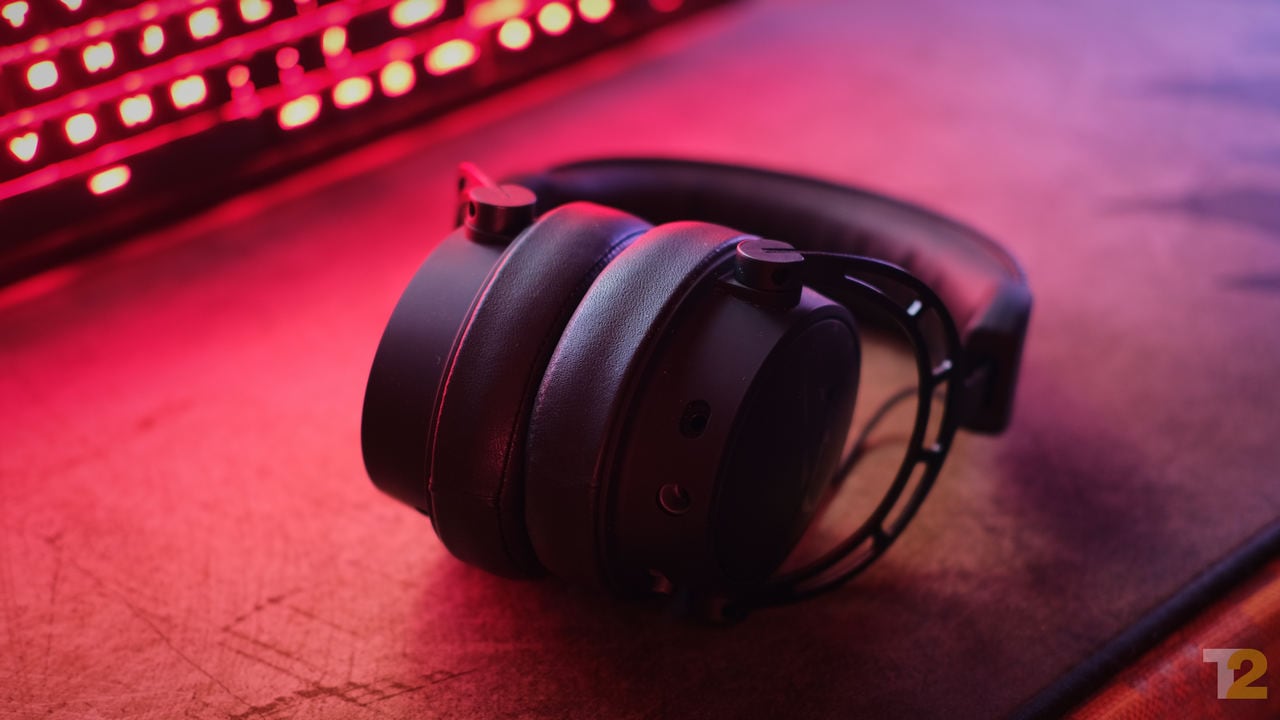A comfortable, feature-rich set that’s well worth the asking price- Technology News, DD FreedishNews
Anirudh RegidiOct 16, 2020 17:00:41 IST
Gaming headsets are tools, utilities that are meant to help you play more competitively. It’s okay if they compromise on audio quality as long as they deliver clarity and precision positioning. The mic must work, and in-line volume control is nice to have. They must also be sturdy — they’re going to be abused, after all — and they must be comfortable to wear for hours at a stretch.

This headset is very well built, and easily among the more comfortable gaming headsets I’ve used. Image: Anirudh Regidi
The Kingston HyperX Cloud Alpha S Blackout ticks almost all of these boxes, and then some.
It’s a well-designed set
Table of Contents
The Blackout’s metal frame is flexible and very sturdy. You can twist it and turn it and it still feels like it’ll last a lifetime. Everything’s firmly planted and feels solid and expensive.
The cushions are large and soft, and can enclose even my fairly large ears without compressing them. I wear spectacles, which is a problem on some closed-backed sets that tend to press a bit too firmly on the head, but this wasn’t an issue with the Cloud Alpha S.

The headset is built like a tank. Image: Anirudh Regidi
I’ve gamed for hours with this set, and I can honestly say I never felt any discomfort. Of course, long gaming sessions can get sweaty, and the Cloud Alpha S isn’t immune to such issues. Thankfully, the earcup padding doesn’t absorb any of that sweat, and can be wiped clean easily.
The mic is detachable, a feature I appreciate because I don’t always play multiplayer games and can’t stand having a mic in my peripheral vision.
The connecting cable is braided and detachable.
The sound card should have been better designed
Kingston has included a USB sound card/mixer of sorts with the headset. This is something I normally appreciate because, usually, these sound better than onboard audio, and also include features like mic and volume controls. Another, more subtle, benefit is that the sound signature will not change device to device, which can be useful if you switch PCs a lot, and are very competitive.

The included remote/USB sound card is disappointing for two reasons. Firstly, it doesn’t sound very good, and secondly, the design means that it’ll probably be dangling just out of reach of your outstretch arm, unless you loop the spare cable round your neck or something. Image: Anirudh Regidi
The HyperX sound card does all of this, and it supports a virtual 7.1 mode (more on that later), but it’s awkward to use.
The awkwardness comes from the design. There are two ways to use the Cloud Alpha: You could plug the headset directly into your PC/laptop with the 3.5 mm combo jack, or you could plug the sound card in via USB, and hook up the headset to the sound card.
The sound card dangles at the end of a 7-foot cable, which is quite cumbersome on a laptop but perhaps convenient for desktop PCs. The headset itself has a 3.5 ft cable sticking out of it.
The problem is two-fold:
- You have 11.5 ft of cable to manage
- Given that the sound card controls the mic and volume, that sound card is 3.5 ft (a little over arm’s length, if you’re about 6 ft tall) away from you. You’d normally expect a remote to be right beside your head for ease of access.

For whatever reason, Kingston decided that it made sense to include 11.5 ft of snaking cable with this headset. Image: Anirudh Regidi
Another issue is that while 3.5 ft of cable is great for laptop use, it’s not long enough if you want to bypass the sound card and connect the headset to your PC directly for when, say, you already have a good sound card.
Audio quality: It’s good
Gaming headset makers tend to approach audio from two angles. They either go all out on bass — some going so far as to add rumble motors (go figure) for ‘enhanced immersion’ — while others sacrifice bass on the altar of clarity and positional accuracy.
These are approaches that make little sense to me. Headphones like the fantastic Audio Technica ATH-M50 and Beyerdynamic DT880 cost the same, while delivering unmatched clarity, positional accuracy, and superb bass response. They only lack an integrated mic and that enigmatic ‘gamer’ aesthetic.
The original HyperX Cloud Alpha was, in fact, the first gaming headset I’d heard that delivered on all fronts: uncompromised audio quality and clarity and accuracy.
The HyperX Cloud Alpha S sounds just as good, and then takes things up a notch. Under each earcup is a little 3-stage switch that you can use to fine-tune the bass response of the set. Stage 1 reduces bass to almost nothing. This kills ambience and immersion, but you’re guaranteed to hear and place every single audio cue in your game. Stages 2 and 3 take bass to about normal, and then slightly boosted levels respectively. It’s worth noting that I found the set to be accurate enough to not need the stage 1 setting, and stage 3 to sound near normal.

These switches on the sides of the earcups adjust bass response. They’re actually quite effective and can be quite useful, depending on the circumstances. Image: Anirudh Regidi
If I’m being critical, this set does fall short of my DT880 headphones, which is better on literally all fronts (bass, mid-range, and voices). I think the audio quality is good enough that you’ll get used to the HyperX set pretty quick, though. Bear in mind that the 880 is meant for studios, is a bit more expensive, and doesn’t include a mic.
Personally, I’d also prefer to ignore that USB sound card, and I would, if it wasn’t for the fact that the mic and volume controls are on it.
Fiddly controller
If you can figure out how to keep the USB controller handy, it’s very convenient. Not only do you get Windows volume control on the device, you also get a mute button and two buttons that can enhance game audio or voice channels as per your preference. The latter system works surprisingly well, and I rarely needed to tweak in-game audio settings when playing with my buddies.
The audio output from the USB sound card is decent enough, but if you fancy yourself an audiophile, stay away from it. It also doesn’t help that most high-end gaming laptops and PC motherboards include better DACs.
The USB card also has a 7.1 ‘surround sound’ emulation mode (activated via a rather prominently placed button) that you’ll want to run a mile from, or maybe not. Just as there are people who love ridiculous bass, there might be some out there who prefer exaggerated channel separation and sharpened voices, because that’s what the emulation mode appears to do.
The microphone is superb
The mic does a fantastic job of isolating voice channels and cutting out background noise. I played on a noisy gaming laptop with my room’s air-conditioning unit turned on, and my friends couldn’t hear any of that background ruckus. The mic also didn’t seem to pick up any sound from my mechanical keyboard and relatively loud G502 mouse.
Thankfully, the mic doesn’t need the bundled USB card to perform well.
Compared to the dedicated Rode NT-USB Mini mic that I normally use for chatting and streaming, the HyperX mic is actually preferable when gaming. To make the Rode mic sound good, I need to enable features like RTX Voice, and perhaps a voice-focussed EQ. There’s no such hassle with the HyperX headset.
Verdict: Proudly carrying forward the Cloud Alpha legacy
I’m happy to report that the HyperX Cloud Alpha S is a capable successor to the OG Cloud Alpha. This is a set that sounds good, is comfortable to use, and features an excellent mic. What more could you ask for, really?
In terms of pricing, the headset is officially priced at Rs 14,000. However, you can usually get it at 11k online, which makes it quite the steal.
#comfortable #featurerich #set #worth #price #Technology #News #DD FreedishNews






























